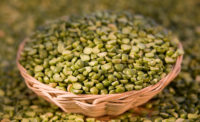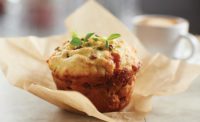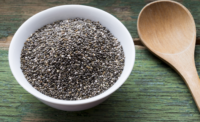For over 500 years, we’ve been looking for the fountain of youth—that magical restorative water that will make us look and feel younger. While the fountain has yet to be discovered, we can find some solace in knowing that many of the foods we eat are becoming healthier for us. And if you are creating new snack foods and bakery products, the good news is that due to the explosion of health-related ingredients, your tools for healthy formulating are plentiful. And some types of snacks and baked goods lend themselves to the capability to go beyond mere fortification and enrichment to the level of health functionality.
According to The Hartman Group, consumers think of functional foods as falling into three main buckets along a continuum of intensity of benefit (“‘Better for Me’—What’s Functional Now,” July 28, 2016). At one end are “inherently functional” foods—in other words, foods with naturally occurring beneficial nutrients, like whole grains and almonds. Then there are “enhanced” functional foods, which are foods that are naturally nutritious but contain added nutrients. Lastly, “scientifically functional” foods are designed to provide a targeted health benefit.
Adding some type of health benefit to snacks can be a positive influence on purchase. Teresa DeJohn, public relations manager, Ganeden, Cleveland, cites a 2015 study by SSI, which found that “47 percent of consumers who didn’t typically purchase snacks said they would be likely to purchase a snack if it contained an added health benefit.”
Healthy almonds
We probably always knew it, but now it’s official. In September, FDA announced that almonds are “healthy.” According to Molly Spence, director, Almond Board of California, Modesto, FDA based its decision on the predominance of good monounsaturated fats (9 grams in 1 oz.), fiber (4 grams in 1 oz.) and polyunsaturated fats (4 grams in 1 oz.), as well as the 6 grams of protein.
Research shows that consumers are well aware of the good nutritional profile of almonds. Plus, almonds deliver on their nutritional promise. Spence notes a meta-analysis study in the Journal of Nutritional Science indicating that eating almonds resulted in significant reductions in total cholesterol, LDL cholesterol and triglycerides (“The effects of almond consumption on fasting blood lipid levels: a systematic review and meta-analysis of randomized controlled trials,” Vol. 5, 2016). “This adds to the weight of evidence that supports the consumption of almonds as part of a healthy diet to maintain healthy blood lipid levels and reduce the risk of heart disease,” she says.
Jeff Smith, director of marketing, Blue Diamond Growers, Sacramento, CA, points out that food manufacturers know that almonds add flavor, texture, crunch and nutrition. “The crunch factor is an important sensory attribute,” he says.
Almonds can also address needs for gluten-free formulations. Blue Diamond has a line of almond flours in three granulations to fit a wide range of applications. “Unlike other gluten-free flours, almond flour has an amazingly smooth texture,” says Smith, “and it remains moist in traditional snacks and baked goods, including crackers.”

Protein power moves
Seeds pack a nutritional punch, and are going into more bars, snacks and breads—often in a highly visible way. For example, Bimbo Bakeries USA recently launched a line of Healthfull breads, two of which have prominent external coatings of seeds.
Randy Kreienbrink , vice president of marketing, BI Nutraceuticals, Long Beach, CA, reports that pumpkin and chia seeds are increasingly popular. BI has gone one step further, selling pumpkin protein powder. “Our pumpkin seed powder is 70 percent protein and, compared to dairy protein, it has a nice, nutty flavor with a flavor profile that fits better with some snacks. And it fits with consumer’s desire for more plant-based proteins,” he says.
Plant proteins are becoming more prevalent in U.S. diets. This move from animal to plant proteins stems from several catalysts. As the result of studies on causes of global warming, we now know that plant-based proteins have less of an environmental impact than animal sources. And, plant-based proteins can have a better nutritional profile than their animal counterparts. Also, for snacks and bakery items—foods that generally don’t feature meat—formulators are taking a closer look at plant proteins as a way to increase satiety and the overall nutritional profile.
One product getting a lot of buzz in this area is Pure Genius brownies. The key differentiator? Chickpeas! By using chickpeas instead of wheat flour, Pure Genius can also stake a gluten-free claim. They’re also vegan and nut-free. Each brownie features 4 grams of plant protein.
Protein ingredients often perform multiple tasks in a food. DuPont Nutrition & Health offers a line of soy protein nuggets for use in snacks, muffins and bars. “Supro Protein Nuggets can add textural and visual appeal to baked goods,” says Troy Boutte, group manager of bakery innovation. The nugget line contains protein in the range of 40 to 90 percent, and comes in a variety of densities and textures for different eating experiences. Some items contain a secondary benefit, such as added fiber or multigrain.
Another interesting ingredient is puffed quinoa, a great fit for snacks. “Puffed quinoa gives crunch and a nutty flavor without adding nuts, so people with allergies don’t have to worry,” says Kreienbrink. “For formulators, it can be an innovative ways to add some protein to snacks like popcorn.”
The importance of omegas
Several types of omega fatty acids are available for use in snacks and baked goods to improve their nutritional profile. While some factor into formulas solely for the purposes of fortification, other sources of omegas, such as specialty oils, can replace fats of lesser nutritive value, boosting the product’s better-for-you appeal.
Polyunsaturated omega-3s like EPA (eicosapentaenoic acid) and DHA (docosahexaenoic acid) are derived from marine sources like certain types of fish or algae, while ALA (alpha-linolenic acid) is common to various seeds and nuts, including flax, chia, hemp and walnuts, as well as select vegetable oils like canola.
Monounsaturated omega-9 canola and sunflower oils, such as those from Dow AgroSciences, are uniquely high in omega-9 (monounsaturated) fatty acid, low in saturated fat and contain zero trans fat, thereby offering a decidedly better nutritional profile than many oils common to snack and bakery production, particularly for applications that require frying.

Multifunctional fiber
Fiber-rich foods like oats fall into the category of inherently functional foods, but ingredient processors often bring added benefits with their fiber ingredients.
PromOat Beta Glucan is a natural fiber made from non-GMO Swedish oats. According to Andy Hoffman, director of health and wellness product development, Tate & Lyle, Hoffman Estates, IL, PromOat can help consumers maintain healthy cholesterol levels, and it also improves freshness perception due to better moisture management in some applications. “This is particularly important to manufacturers who are creating products like granola and protein bars, because our ingredient provides a chewy texture throughout shelf life,” he says.
Oliggo-Fiber chicory root fiber is both a fiber source and a prebiotic, meaning it can help feed beneficial bacterial in the gut. “Consuming 5 grams of chicory root fiber per day stimulates the microflora in the digestive tract, helping to maintain a neutral balance,” says Pam Stauffer, global marketing programs manager, Cargill, Minneapolis.
Beyond its nutritional benefits, chicory root fiber provides a number of functional properties. “It serves as a fat mimetic, mimicking the texture of fat, giving the added richness and improved mouthfeel to lower fat foods,” says Stauffer. “It also acts as a bulking agent, replacing the bulk left from sugar reduction. In addition, it’s a flavor modulator, making an excellent partner for high-intensity sweeteners and polyols in reduced-sugar applications.”
Chicory root fiber has seen use in some varieties of snack bars from Udi’s Healthy Foods and the General Mills brand Fiber One.
Rice bran provides protein and fiber in one fell swoop. According to Robert Smith, Ph.D., CEO, RiceBran Technologies, Scottsdale, AZ: “The bran contains the most-nutrition benefits of the rice plant. Our Proryza Gold is a rice bran derivative with 25 percent protein and 50 percent dietary fiber. It is ideally suited for the development of healthy snacks where protein and fiber are important. Another benefit is that rice bran is also gluten-free and non-GMO.”
Ardent Mills, Denver, has an extensive line of whole-grain offerings that offer nutritional benefits, including vitamins, minerals, fiber and other nutrients. “We want developers to know that whole grains can be effectively used without compromising taste in mainstream applications,” says Zachery Sanders, director of marketing. Sustagrain, he notes, is a high-fiber barley ingredient that delivers three times the fiber of oats and 10 times the fiber of brown rice.
Kellogg’s Special K Multigrain Crackers with Quinoa, available in Sea Salt or Parmesan Sesame, are made with whole-grain barley flour.
It’s always a challenge for formulators to make foods that are low in calories, have reduced sugar and also taste good. But soluble vegetable fibers are able to meet these challenges. According to Doris Dougherty, technical representative, Fibersol, ADM/Matsutani, Decatur, IL, the Fibersol ingredient range can help achieve “total or partial replacement of sugar.” Additionally, Fibersol-2 can help manufacturers achieve dietary fiber levels to claim “good” or “excellent” source of dietary fiber, she notes.
New developments in probiotics
Gut health has become a hot topic as nutrition scientists learn more about how the state of the microbiome in our gut can impact our overall health. Consuming probiotics has been promoted as one way to right any wrongs you have done to yourself by consuming an unhealthy diet. Until recently, manufacturers were unable to formulate with probiotics outside of the dairy case due to instability issues. However, Ganeden has a developed a patented probiotic, GanadenBC30 that can survive in snack foods.
Mike Bush, president, Ganeden, confirmed that GanedenBC30 is one of the only probiotics that can survive in snack foods due to a “protective layer that enables the cells to stay dormant until reaching the end user’s digestive tract.” Due to its process stability, GenedanBC30 can be used in almost any snack food—from confections and muffins to granola and nutrition bars. “The efficacy of this probiotic has been documented in 24 peer reviewed papers, which allow manufacturers using GanedenBC30 to make a variety of health claims, including those related to digestive health and immune health support. The most-recent studies also confirm the claim that GenedenBC30 enables the body’s protein utilization,” Bush says.
While we may not have yet discovered the fountain of youth, thanks to a plethora of truly better-for-you and functional foods, we might be able to snack our way to a healthier life.
Fortifying tortillas
Since 1998, FDA has required most wheat flour to be enriched with folic acid to help prevent neural tube defects, like spina bifida. Now, as of April 2016, FDA has opened the door to voluntary corn masa folic acid fortification.
This move is particularly important to Hispanic women living in the U.S. who primarily consume corn—and not wheat—via tortillas. It could also have a beneficial impact for consumers who follow a gluten-free diet, but regularly include corn as a staple.
Shortly after FDA’s announcement, Gruma—owner of the international tortilla and tortilla chip brand Mission—announced that it would be ready to offer tortillas fortified with folic acid by later in 2016.












